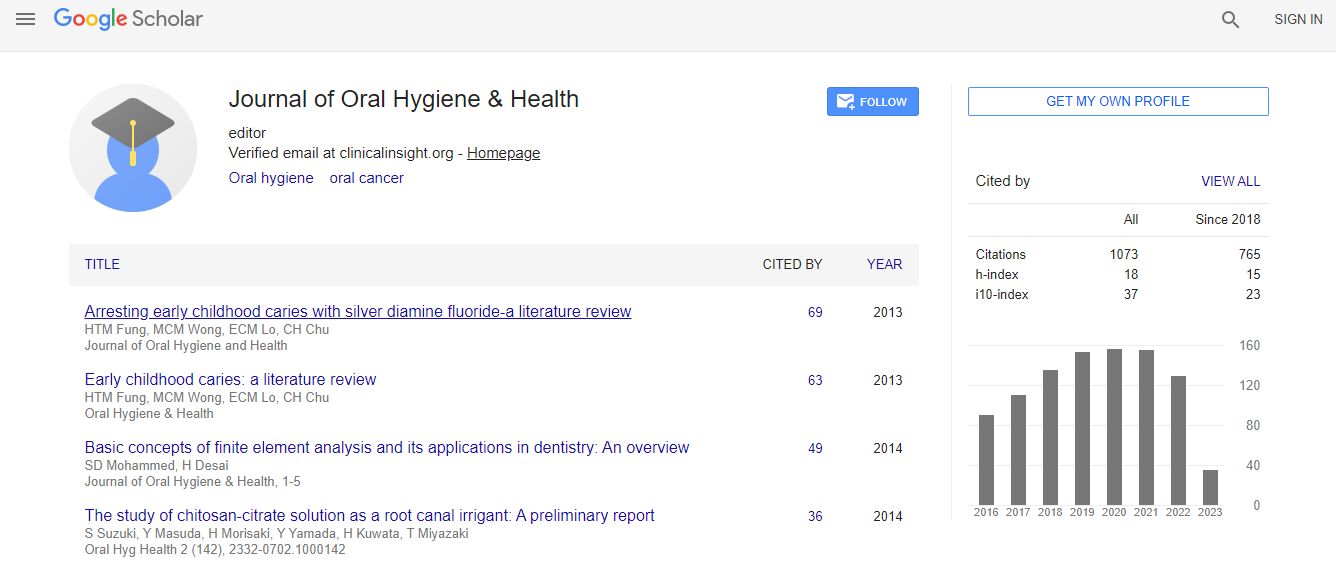Our Group organises 3000+ Global Conferenceseries Events every year across USA, Europe & Asia with support from 1000 more scientific Societies and Publishes 700+ Open Access Journals which contains over 50000 eminent personalities, reputed scientists as editorial board members.
Open Access Journals gaining more Readers and Citations
700 Journals and 15,000,000 Readers Each Journal is getting 25,000+ Readers
Google Scholar citation report
Citations : 1073
Journal of Oral Hygiene & Health received 1073 citations as per Google Scholar report
Journal of Oral Hygiene & Health peer review process verified at publons
Indexed In
- Index Copernicus
- Google Scholar
- Open J Gate
- JournalTOCs
- RefSeek
- Hamdard University
- EBSCO A-Z
- OCLC- WorldCat
- Publons
- Geneva Foundation for Medical Education and Research
- Euro Pub
- ICMJE
Useful Links
Recommended Journals
Related Subjects
Share This Page
Advances in implant supported restorations using computer aided designing/computer aiding manufacturing (CAD/CAM) techniques
2nd International Conference on Restorative Dentistry and Prosthodontics
Elbanna L F
Al-Azhar University, Egypt
Posters & Accepted Abstracts: J Oral Hyg Health
Abstract
Implant dentistry has seen rapid and remarkable progress in recent years. Several questions have been raised concerning materials as well as designs of both implants and implant abutments to achieve maximum clinical success rates. An understanding of their properties will help the clinician in selecting the ideal prosthesis for each clinical case, while promoting final esthetic outcomes. With the evolving technology and knowledge, an update of the current trends is necessary. The use of implants to replace missing teeth in the esthetic zone is challenging. The restorations are subjected to direct visual comparison with the adjacent natural teeth. Perfect three dimensional implant positioning and well-designed superstructures are therefore essential to mimic the appearance of a natural tooth and to achieve an optimal esthetic outcome. The development of computer aided design, computer aided manufacturing (CAD/ CAM) technology has focused on precise and consistent manufacturing of zirconia ceramics with high strength and toughness. CAD/CAM technology relies on exact dimensional predictions to compensate for sintering shrinkage, and is an economical and highly reproducible method for manufacturing complex and individual geometrics from a green or presintered ceramic material. Zirconia has become one of the dominant types of ceramic used for a variety of CAD/CAM restoration classes, including framework/ hand veneer, framework/pressed veneer, framework milled/veneer, full contour fixed prosthodontics, implant abutments, and large implant supported substructures. Although zirconia is currently the strongest dental ceramic material available, fabrication variations and finishing procedures can affect the longevity of this material as well as the veneer porcelain. Having a good working relationship with a dental laboratory is strongly recommended. Of all-ceramic restorations produced in 2010, zirconia based units represented approximately 50% of that total. The introduction of CAD/CAM has facilitated the use of superior dental ceramic, to enhance the fabrication of consistent and predictable restorations in terms of strength, marginal fit and esthetics. CAD/CAM technology in combination with zirconia ceramic has increasingly gained popularity in implant dentistry. Marginal accuracy, retention and color matching of esthetic implant supported crown are critical determinant in the over all success of implant therapy and yet it remains challenge. Especially with the innovative revolution of CAD/CAM systems designs and materials which has improved and refined endlessly. So on understanding of their properties is a demand for helping the clinician in selecting the ideal prosthesis for each clinical case while promoting final esthetic outcomes. In this lecture we will spot light in a comparative way between different CAD/ CAM techniques [Full contour CAD/CAM technique, Anatomical core CAD/CAM technique, over press CAD/CAM technique]. We will show their marginal accuracy, color matching and retention when used as a cemented versus screw retained esthetic implant supported crowns. Digital implant dentistry is the ��?here and now� for dental implant practitioners. From digital treatment planning and delivery to patient communication, new technologies are changing the way dentists practice implant dentistry. The digital advancements in dentistry are growing at an incredible speed.Biography
Email: l_elbanna@me.com

 Spanish
Spanish  Chinese
Chinese  Russian
Russian  German
German  French
French  Japanese
Japanese  Portuguese
Portuguese  Hindi
Hindi 
